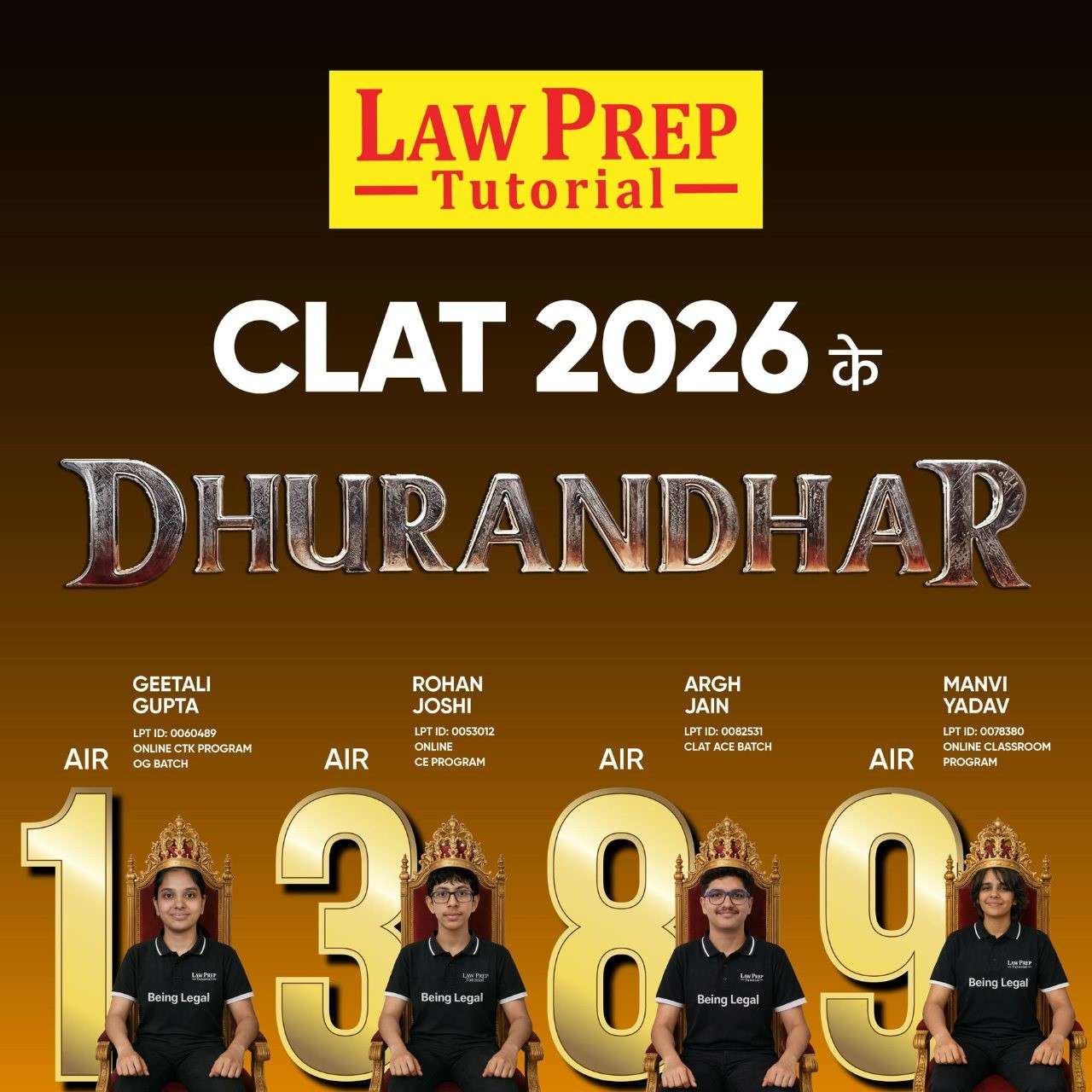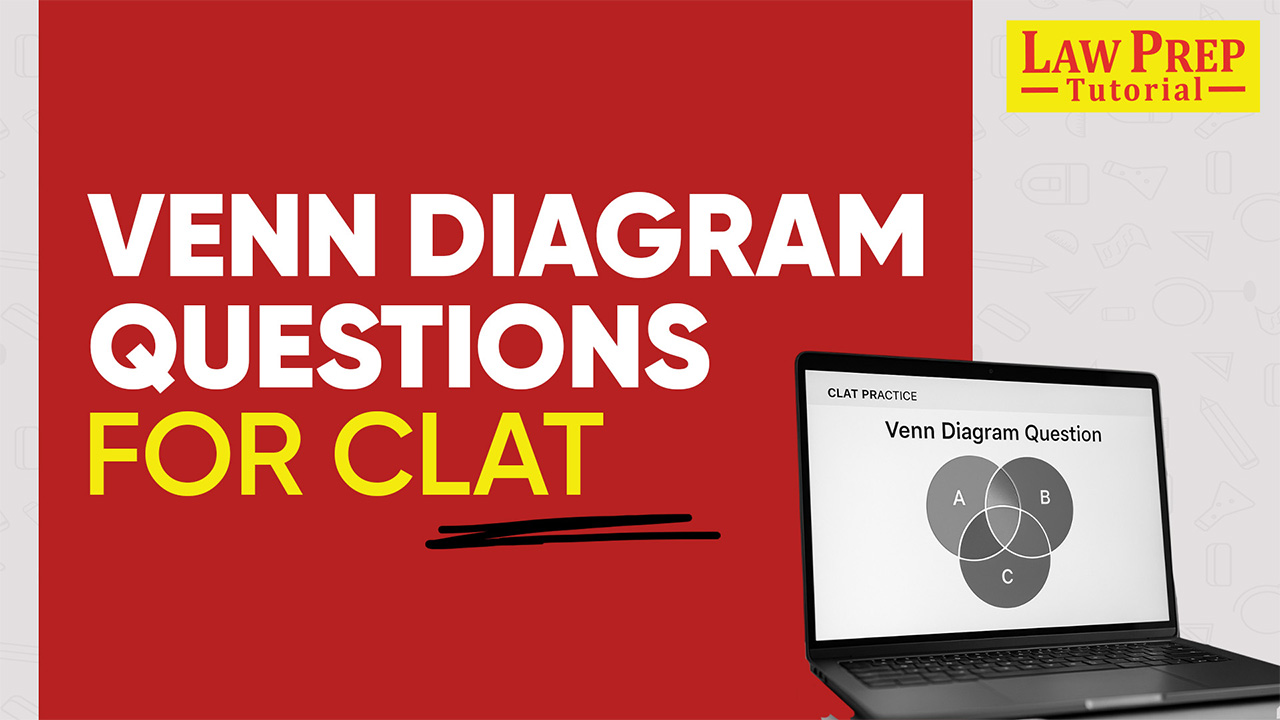Venn diagram questions in CLAT are a crucial part of the logical reasoning section. These questions test your ability to understand relationships between different sets, making them essential for problem-solving and analytical skills.
Regular practice with a variety of Venn diagram problems helps in mastering this topic. To excel, solve sample questions, take CLAT mock tests, and review previous year’s papers.

Importance of Logical Reasoning in CLAT
The logical reasoning section is a critical component of the CLAT exam, designed to evaluate a candidate’s ability to analyze patterns, deduce conclusions, and solve complex problems.
This section includes a variety of question types, including Venn diagrams, which test your understanding of relationships and set theory. Excelling in the logical reasoning section is essential, as it not only boosts your overall score but also enhances your problem-solving skills, which are fundamental for a successful legal career.
Regular practice and familiarity with different types of CLAT logical reasoning questions are key to performing well in this section.
| Subjects | No. of Questions | Weightage |
| English Language | 22-26 | 20% |
| Current Affairs, including General Knowledge | 28-32 | 25% |
| Legal Reasoning | 28-32 | 25% |
| Logical Reasoning | 22-26 | 20% |
| Quantitative Techniques | 10-14 | 10% |
Upcoming CLAT Exams:
Venn Diagram Questions in CLAT
Following are the 50 Venn Diagram Questions for CLAT:
Passage 1:
In an examination there are three subjects. 40 students failed in only mathematics, 50 students failed in only Chemistry and 60 students failed in only Physics. 200 students passed in all the subjects. 400 students passed in Mathematics, 550 students passed in Physics, 500 students passed in Chemistry. The number of students who failed in all the subjects is 25% of the students who passed in mathematics.
Q1. How many students failed in one or more than one subjects?
(a) 800
(b) 700
(c) 600
(d) 550
Q2. The number of students failed in all subjects is what % of students passed in all subjects?
(a) 40% (b) 50%
(c) 30% (d) 20%
Q3. What is the ratio between the number of students failed in physics and number of students failed in Chemistry?
(a) 1 : 2 (b) 2 : 1
(c) 1 : 1 (d) 9 : 10
Q4. How many students passed in only one subjects?
(a) 460 (b) 290
(c) 350 (d) 550
Q5. How many students appear in that examination?
(a) 900 (b) 800
(c) 1000 (d) 1200
Passage 2:
A total of x students appeared in a class test consisting of three papers, viz Physics, Chemistry and Maths. The following Venn diagram shows the number of students who passed these three papers. None of the students failed in all the three papers together. Answer the given questions based on this diagram.
Q6. How many students are there who passed in Chemistry and Maths but failed in Physics?
(a) (b)
(c) (d)
Q7. What is the difference between the number of students who passed in Chemistry and the number of students who passed in Physics? (The number of students who passed in all the three papers is 15.)
(a) 5 (b) 10
(c) 15 (d) 20
Q8. How many students are there who passed in exactly one paper, if the number of students who passed in exactly two papers is 110?
(a) 160 (b) 165
(c) 170 (d) 175
Q9. The number of students who passed in at least two papers is what percentage of the total number of students?
(a) (b)
(c) 44% (d)
Q10. The number of students who passed in only Maths is what percentage more than the number of students who passed in all the three papers?
(a) 20% (b) 80%
(c) 120% (d) 400%
Important CLAT Questions for Practice:
| CLAT Legal Reasoning Questions | CLAT Logical Reasoning Questions |
| CLAT English Questions | CLAT GK Questions |
Passage 3:
Following Venn-diagram shows the result of a survey conducted on people about their interest in different sports. Answer the following questions based on this diagram.
Q11. How many people are there who like exactly three types of sports out of the given four?
(a) 98 (b) 104
(c) 108 (d) 112
Q12. The number of people who like exactly two types of sports is what percentage of the total number of people surveyed?
(a) 40% (b) 32%
(c) 30% (d) 26%
Q13. What is the difference between the number of people who like either only Cricket or only Soccer and the number of people who like either only Hockey or only Tennis?
(a) 1 (b) 3
(c) 5 (d) 7
Q14. What is the ratio of the number of people who like Cricket to the number of people who like only Tennis?
(a) 40:13 (b) 59:16
(c) 63:23 (d) 64:25
Q15. The number of people who like exactly one type of sports is what percentage of the total number of people surveyed?
(a) 42.5% (b) 45.4%
(c) 47.8% (d) 51.1%
Passage 4:
From a class a total of 200 students appeared in an examination consisting three papers P1, P2 and P3. 56% of students passed in paper P1, 63% passed in P2 and 56.5% passed in P3. 11% students passed only in paper P1 andP2 , 8% passed only in paper P1 and P3, and 22% students passed in all three papers. No student failed in all three papers.
Q16. How many students passed in paper P2 andP3 but failed in P1?
(a) 22 (b) 24
(c) 25 (d) 28
Q17. What is the ratio of the number of students who passed only in paper P2 to the number of students who passed in P3 only?
(a) 3:2 (b) 4:3
(c) 5:4 (d) 6:5
Q18. The number of students who passed in paper P1 only is what percentage of the number of students who passed in paper P1 and P3 but failed in paper P2?
(a) 187.5% (b) 157.5%
(c) 112.5% (d) 97.5%
Q19. The number of students who passed in at most one paper is what percentage of the total number of students in the class?
(a) 43.5% (b) 44.5%
(c) 45.5% (d) 46.5%
Q20. What is the difference between the number of students who passed in paper P3and the number of students who passed only in paper P3?
(a) 81 (b) 83
(c) 85 (d) 87
Passage 5:
From a group of x sportsmen 50% participated in Olympic games, 53% participated in Asian and 42% participated in Commonwealth Games (CWG). Ten percent participated in Olympics and Asian but not in CWG, 14% participated in Olympics CWG but not in Asian, and 5% participated in Asian and CWG but not in Olympic Games. Based on the information given, answer the following questions.
Q21. If x is equal to 300, how many sportsmen participated in all three events?
(a) 20 (b) 24
(c) 30 (d) 36
Q22. If the number of persons who participated in only Olympic Games is 81, what is the total number of sportsmen?
(a) 360 (b) 420
(c) 450 (d) 480
Q23. If the number of sportsmen who participated in all three events is 48, what is the number of sportsmen, who participated in Asian?
(a) 272 (b) 296
(c) 310 (d) 318
Q24. If the number of sportsmen who participated in exactly two events is 58, what is the number of persons who participated in all three events?
(a) 16 (b) 20
(c) 24 (d) 12
Q25. If x is equal to 300, what is the ratio of the number of sportsmen who participated only in Olympic Games to the number of persons who participated only in CWG?
(a) 3 : 2 (b) 4 : 3
(c) 5 : 4 (d) 6 : 5
Key resources to explore after your CLAT exam
| CLAT 2026 Result | CLAT 2026 Answer Key |
| CLAT 2026 Counselling | CLAT 2026 Admit Card |
| CLAT Marks vs Rank | CLAT 2026 Rank Predictor |
| CLAT 2026 Question Paper | CLAT 2026 Toppers |
| CLAT 2026 College Predictor |
Passage 6:
In a class test, total 250 students appeared. Out of that 16% students passed only in Physics in which B : G is 3 : 2. Again, 24% passed only in Chemistry paper in which B: G is 7 : 5. Also, 30% students passed only in Maths and B : G is 7 : 8. Besides 8% students passed in Physics and Chemistry but failed in Maths and among them B : G is 2 :3. Again, 6% students passed in all the three papers and among them B : G = 2 : 3. Also, 9.6% students passed in Physics and Maths but failed in Chemistry and among them B : G is 3 : 1. None of them failed in all the three subjects and the difference between the total number of boys and the total number of girls who appeared in the exam is 14.
Answer the following questions based on the above information. (B : G is the ratio of the number of boys to the number of girls.)
Q26. What is the ratio of the number of boys to the number of girls who passed in Chemistry and Math but failed in Physics?
(a) 3:5 (b) 4:5
(c) 4:7 (d) 5:7
Q27. How many girls are there who passed exactly in one subject?
(a) 72 (b) 75
(c) 78 (d) 81
Q28. What is the total number of boys who passed exactly in two subjects?
(a) 28 (b) 32
(c) 36 (d) 40
Q29. The number of girls who passed in Physics and Chemistry but failed in Maths is what percentage of the number of girls who passed in Chemistry and Maths but failed in Physics?
(a) 75% (b) 80%
(c) 120% (d) 150%
Q30. The number of boys who passed only in Chemistry is what percentage of the number of girls who passed either only in Maths or only in Physics?
(a) 72.5% (b) 65%
(c) 62.5% (d) 60%
Passage 7:
In a company total 500 persons work there. Out of that, 53.6% employees have bank Account in SBI, 44% in ICICI and 34% in HDFC. 5% of total employees have account in SBI and HDFC but not in ICICI, and 180% of this number have account in SBI and ICICI but not in HDFC. 3.6% employees have account in all three banks and 10.4% employees have account in ICICI and HDFC but not in SBI.
Answer the following questions based on this information.
Q31. How many employees are there who have account in ICICI Bank only?
(a) 75 (b) 105
(c) 180 (d) 220
Q32. What percentage of employees holds account in HDFC only?
(a) 9% (b) 12%
(c) 15% (d) 24%
Q33. How many people hold account in exactly one bank?
(a) 270 (b) 320
(c) 350 (d) 360
Q34. The number of employees who hold account in all three banks is what percentage of the number of employees who have account in SBI only?
(a) 6% (b) 8%
(c) 10% (d) 12%
Q35. The number of employees who hold account in at least two banks is what percentage of the number of employees who hold account in almost two banks? (Answer in approximation.)
(a) 24% (b) 29%
(c) 34% (d) 39%
Passage 8:
In 2010, In the Olympic event there were three tracks, 200 meters long, 400 meters long and 600 meters long. 250 athletes participated in the race. They ran either 200 meters race or 400 meters race or 600 meters race or two out of those three races or all the three races. 102 of them ran 200 meters race, 112 of them ran 400 meters race, and 138 of them ran 600 meters race. 62 of them ran only 400 meters of race and 42 of them ran both 200 meters race and 600 meters race but not 400 meters race. In 2014, a new 800 meters long track was added and 40 more athletes participated in the race who ran only 800 meters race. All the previous event athletes continued to participate in the same race/races that they had participated in 2010. Some of the old athletes also started participating in 800 meters race and there were total 93 athletes who participated in 800 meters race. None of the athletes ran all the four races and none of the athletes ran both 200 meters race and 800 meters race. Of the 27 athletes who ran both 400 meters race and 600 meters race but not 200 meters race in 2010, 9 ran 800 meters race in 2014. 42 athletes ran only 600 meters race in 2014. 27 athletes ran both 400 meters race and 800 meters race and no other race in 2014. 23 athletes ran both 200 meters race and 400 meters race in 2010.
Q36. In 2014, how many of athletes had participated in at least in any of the three races out of four races?
(a) 35 (b) 32
(c) 39 (d) 37
Q37. In 2014, the number of athletes who had participated only in 200 meters race and 400 meters race but no other race is approximately how much percentage more than/less than the number of athletes who had participated only in 600 meters race and 800 meters race but no other race? (rounded off two decimal)
(a) 23.53% (b) 27.53%
(c) 21.53% (d) 19.53%
Q38. In 2010, how many of the athletes had participated in exactly two races?
(a) 92 (b) 72
(c) 82 (d) 84
Q39. In 2014, approximately what percentage of the total athletes had participated in exactly two races?
(a) 31.11$ (b) 34.14%
(c) 29.11% (d) 27.17%
Q40. In 2010, how many of the athletes had participated in exactly one race?
(a) 132 (b) 148
(c) 136 (d) 158
Free CLAT Study Material for You:
| CLAT Previous Year Papers PDF | CLAT Sample Papers |
| CLAT Syllabus PDF | Free CLAT Coaching |
| CLAT Current Affairs | CLAT Topper Interviews |
| CLAT Videos | CLAT Mock Tests |
Passage 9:
There are 1000 students in a college. Out of 1000 students some appeared in exams ‘X’, ‘Y’ and ‘Z’ while some not. Number of student not appeared in any exam is equal to number of students appeared in exam ‘Z’ only. Number of students appeared in exam ‘Y’ is 360. Ratio of number of students appeared in exam ‘X’ and ‘Y’ only to number of students appeared in exam ‘Y’ and ‘Z’ only is 2 : 3. Number of student appeared in exam ‘X’ and ‘Z’ both is half of number of students appeared in only exam ‘Z’. Number of students appeared in exam ‘X’ only is 50% more than number of students appeared in ‘Y’ only. Number of students appeared in all the three exam is 4% of the total number of students in the college. Number of students appeared in ‘Y’ exam only is same as number of students appeared in ‘Y’ and ‘Z’ only.
Q41. How many students appeared in at least two exams?
(a) 240 (b) 260
(c) 300 (d) 360
Q42. How many students appeared in two exams only?
(a) 280 (b) 220
(c) 340 (d) 300
Q43. How many students appeared in at most two exams?
(a) 240 (b) 260
(c) 300 (d) 960
Q44. How many students not appeared in exam Y?
(a) 440 (b) 360
(c) 540 (d) 640
Q45. How many students appeared in exam X or in exam Z?
(a) 240 (b) 360
(c) 500 (d) 680
Resources for CLAT PG Preparation:
Passage 10:
There are some viewers of 3 different TV show like (Mahabharata, Ramayana, and Chandrakanta).
Viewers like at least one or at most 3 of the show on Tv. 50 People Does not like any of three shows.
Further it is known that, Ratio of number of persons who like Ramayana, Mahabharata and Chandrakant is 4:4:7. The person who like Ramayana and Mahabharata but not Chandrakanta is 120. 200 persons like Only Chandrakanta. Number of Person Who like only Chandrakanta and Mahabharata is equal to the number of Person who like only Chandrakanta and Ramayana. 80 Persons like all the tv show. 115 persons like Ramayana and Chandrakanta together. 35 persons who like only Ramayana.
Q46. Total number of persons who like at least two shows is how much more or less than the person who like only two shows?
(a) 80 (b) 85
(c) 90 (d) 100
Q47. Find total viewers who like the shows and don’t like the shows?
(a) 600 (b) 700
(c) 800 (d) None of these
Q48. Total number of Ramayana viewers are how much % more or less than the total number of Mahabharata viewers?
(a) 3% (b) 10%
(c) 0% (d) 6%
Q49. Number of persons who don’t like any show is now watching Ramayana. Now how many persons are watching only Ramayana?
(a) 75 (b) 80
(c) 70 (d) 85
Q50. Person who like Ramayana and Mahabharata is how much more or less than the number of persons who like only Chandrakanta?
(a) 65 (b) 50
(c) 70 (d) 35
Best Books for CLAT Logical Reasoning
| Book Name | Author Name |
| Modern Approach to Verbal and Non-Verbal Reasoning | R.S. Aggarwal |
| GMAT Official Guide | – |
View CLAT Preparation Books for All Subjects!
CLAT Previous Year Papers
To help you prepare effectively and be ready for the CLAT exam date 2026, we have shared the collection of CLAT previous year papers. These papers provide valuable insights into the exam format and types of questions asked, helping you refine your study strategy.
Checkout CLAT previous Year papers of 18 years.
CLAT Coaching Across Different Cities of India

